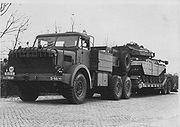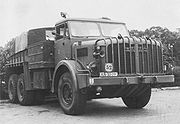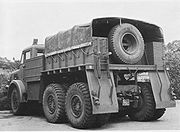
Thornycroft Antar
Encyclopedia

Tractor unit
A tractor unit, prime mover , road tractor, or traction unit is a heavy-duty commercial vehicle within the large goods vehicle category, usually with a large displacement diesel engine, and several axles. The tractor unit serves as a method of moving trailers...
built by Thornycroft
Thornycroft
Thornycroft was a United Kingdom-based vehicle manufacturer which built coaches, buses, and trucks from 1896 until 1977.-History:Thornycroft started out with steam vans and lorries. John Isaac Thornycroft, the naval engineer, built his first steam lorry in 1896...
from the 1940s onwards. For some decades it was the standard tank transporter
Tank transporter
A tank transporter is a specialized road vehicle for the transport of tanks, to and from the battlefield or during peacetime. They are necessary to limit the mileage of the tracked vehicles and also to reduce wear on road surfaces which can easily be damaged by such heavy vehicles...
of the British Army
British Army
The British Army is the land warfare branch of Her Majesty's Armed Forces in the United Kingdom. It came into being with the unification of the Kingdom of England and Scotland into the Kingdom of Great Britain in 1707. The new British Army incorporated Regiments that had already existed in England...
and was also used by other nations.
History



Origins
The civilian version of the Antar was developed in the late 1940s as an oilfield vehicle for transporting pipes over rough ground. They were of 6x4 layout (i.e. six wheels, four of them driven), with the front (steering) axle undriven and with twin wheels on both driven (rear) axles. The vehicle was designed from the outset for off-road use, like the earlier Scammell PioneerScammell Pioneer
The Scammell Pioneer R100 was a British vehicle that was used in the Second World War. The basic vehicle was used as an artillery tractor for heavier pieces such as the 7.2 inch howitzer. This had an 8-ton winch and an overhead runway with a 10-cwt hoist. Early war use included towing the six inch...
and unlike the road-going Diamond T
Diamond T
The Diamond T was an American automobile manufactured in Chicago from 1905 until 1911 by the Diamond T Motor Car Company. It was a powerful touring car . The company later became known for its trucks...
it was eventually to replace.
The engine, the Meteorite
Rolls-Royce Meteorite
The Rolls-Royce Meteorite, also known as the Rover Meteorite was a V8 petrol or diesel engine of capacity, and was derived from the Rolls-Royce Meteor. In essence it was two-thirds of a V12 Meteor, and it shared the Meteor's 60° vee angle...
, was a cut-down V8 version of the V12 Rolls-Royce Meteor
Rolls-Royce Meteor
The Rolls-Royce Meteor was a British tank engine of the Second World War.It was developed from the Rolls-Royce Merlin aero-engine by W. A. Robotham and his chassis design and development division at Belper, as they were not involved in aero-engine work...
used in tanks, itself a non-aero version of the Merlin
Rolls-Royce Merlin
The Rolls-Royce Merlin is a British liquid-cooled, V-12, piston aero engine, of 27-litre capacity. Rolls-Royce Limited designed and built the engine which was initially known as the PV-12: the PV-12 became known as the Merlin following the company convention of naming its piston aero engines after...
and made under licence by the Rover Co Ltd. Early Antars used the petrol version made by Rover and by the early 1950s the Rolls-Royce
Rolls-Royce Limited
Rolls-Royce Limited was a renowned British car and, from 1914 on, aero-engine manufacturing company founded by Charles Stewart Rolls and Henry Royce on 15 March 1906 as the result of a partnership formed in 1904....
-manufactured diesel
Diesel engine
A diesel engine is an internal combustion engine that uses the heat of compression to initiate ignition to burn the fuel, which is injected into the combustion chamber...
versions of the engine.
Choice of the "Mighty Antar" name
The name "Antar" was a reference to Antar Ibn Shadded, a pre-Islamic ArabPre-Islamic Arabia
Pre-Islamic Arabia refers to the Arabic civilization which existed in the Arabian Plate before the rise of Islam in the 630s. The study of Pre-Islamic Arabia is important to Islamic studies as it provides the context for the development of Islam.-Studies:...
poet-warrior. The intended lead customer for the "Mighty Antar" was the Anglo-Iranian Oil Company, previously the Anglo-Persian Oil Company, and this was a deliberate move to flatter the customer.
Introduction into Army service
In 1951, the first Antars entered British ArmyBritish Army
The British Army is the land warfare branch of Her Majesty's Armed Forces in the United Kingdom. It came into being with the unification of the Kingdom of England and Scotland into the Kingdom of Great Britain in 1707. The new British Army incorporated Regiments that had already existed in England...
service. These were fixed-body steel-built ballast tractor
Ballast tractor
A ballast tractor is a heavy haulage road vehicle designed to pull or push heavy or exceptionally large loads. Unlike the tractor unit from an articulated trailer, the ballast tractor is designed or adapted to pull or push loads from a drawbar...
s and were given the design number FV 12001 and the designation Tractor 30-ton GS 6x4. They could haul the new 50-ton Dyson FV 3601 trailers that were being used to carry the new and heavier Centurion tank
Centurion tank
The Centurion, introduced in 1945, was the primary British main battle tank of the post-World War II period. It was a successful tank design, with upgrades, for many decades...
s. A 20-ton winch was fitted behind the cab, although just provided for loading the trailer rather than for recovery.
At this time, the intention was that the even heavier Conqueror tank
Conqueror tank
The FV 214 Conqueror, also known as "Tank, Heavy No. 1, 120 mm Gun, Conqueror" was a British heavy tank of the post-war era. It was developed as a response to the Soviet Joseph Stalin IS-3 heavy tanks and carried a larger 120 mm gun compared to the 20-pounder gun carried by its peer the...
would be transported by a whole new transporter of equally large capacity, the Leyland FV 1000. This was 2 feet (61 cm) wider than the Antar, as the Antar had in turn been 2 feet (61 cm) wider than the Diamond T. They were to be equipped with a semi-trailer
Semi-trailer
A semi-trailer is a trailer without a front axle. A large proportion of its weight is supported by a road tractor, a detachable front axle assembly known as a dolly, or the tail of another trailer...
of 60 tons capacity, given the design number FV 3301. This design was ungainly and top-heavy when loaded, being high at the rear to clear the wheels and sloping downwards towards the front to better place the weight of the load.
Partly inspired by this semi-trailer, a new FV 12002 version of the Antar was developed as a tractor unit to haul it. This was a graceful swan-neck design and had only a small hump over the rear wheels, making loading by the rear ramps simpler. The trackways on which the tank sat were carried outboard of the trailer frame itself, which rose up between them at the front to form the swan neck, sloping only gently to clear the tank's hull. This gave a stronger and yet more compact layout than the ungainly step of the FV 1000 project's. The first version of this was the 16-wheeled FV 3001 of 60 tons capacity. This was later refined as the FV 3005 with smaller wheels, then the 50-ton-capacity FV 3011 (when using the Taskers/Sankey trailer) for carrying the Centurion.
As the semi-trailer Antars entered service through 1953 to 1955, and after the abandonment of the FV 1000 project, they replaced the American Diamond T
Diamond T
The Diamond T was an American automobile manufactured in Chicago from 1905 until 1911 by the Diamond T Motor Car Company. It was a powerful touring car . The company later became known for its trucks...
that had served during the Second World War as the British Army's main tank transporter
Tank transporter
A tank transporter is a specialized road vehicle for the transport of tanks, to and from the battlefield or during peacetime. They are necessary to limit the mileage of the tracked vehicles and also to reduce wear on road surfaces which can easily be damaged by such heavy vehicles...
.
Recovery vehicles
The Antar tractor itself was heavier, at 20 tons, than any available recovery vehicle could lift for a suspended tow. There had been plans in the super-heavy FV 1000 and FV 1200 series for recovery vehicles, but these were cancelled with the rest of the project. As an ad hoc measure in 1952, an RASCRASC
RASC may be:* Reconfigurable Application-Specific Computing, a specialized reconfigurable computer for high-performance computing* Research and Advocacy Standing Committee, part of the Singapore Children's Society...
officer devised a bolt-on recovery jib that could be fitted to one Antar to make it capable of the suspended towing of another, although this modification was never approved for mass production.
Later service
In the early 1960s the Mark 3 entered service, to support the increasing weight of later Centurion models and also future plans for the Chieftain tankChieftain tank
The FV 4201 Chieftain was the main battle tank of the United Kingdom during the 1960s and 1970s. It was one of the most advanced tanks of its era, and at the time of its introduction in 1966 had the most powerful main gun and heaviest armour of any tank in the world...
. These were the last Antars in service, remaining until the mid-1980s. The Mark 3 is visually distinct from the earlier models, the use of an inline engine rather than the wide vee of the Meteorite allowing a much narrower bonnet.
The Mark 3 used either a 50- or 60-ton semi-trailer (numbered as FV 12004) or could be converted to the FV 12006 ballast tractor configuration for hauling the 50-ton Dyson full trailer.
Replacement
By the late 1960s, it was clear that the Antar, even when re-engined, was an old design and replacement would be needed. There was also concern over the spares situation, as they were out of production and Thornycroft had been absorbed, via AEC, into the vast mass of Leyland. The Antar was replaced by the Scammell Commander in 1986.Antar Mark 1B
1B denotes ballast body for Dyson trailer.- length: 26 ft (7.9 m)
- width: 10 ft 3 in (3.1 m)
- height: 10 ft (3.0 m)
- weight: 43,240 lb (19,610 kg)
- Engine: Rolls RoyceRolls-Royce LimitedRolls-Royce Limited was a renowned British car and, from 1914 on, aero-engine manufacturing company founded by Charles Stewart Rolls and Henry Royce on 15 March 1906 as the result of a partnership formed in 1904....
18.4 litre MeteoriteRolls-Royce MeteoriteThe Rolls-Royce Meteorite, also known as the Rover Meteorite was a V8 petrol or diesel engine of capacity, and was derived from the Rolls-Royce Meteor. In essence it was two-thirds of a V12 Meteor, and it shared the Meteor's 60° vee angle...
Mk-204 V8 petrol (60 degree overhead cam, four valve, twin carb, twin magneto with two spark-plugs per cylinder). Power: 285 bhp (213 kW) at 2,000 rpm.
- Transmission: Four-speed full "crash gearboxCrash gearboxA crash gearbox, also known as a crash box, is a transmission type used in old cars, trucks, and other automotive vehicles. It is more properly called a "sliding mesh" gearbox and has the nickname "crash" because it is difficult to change gears, so gear changes are often accompanied by loud noises...
" with three-speed transfer casing and power takeoff. Two live worm-drive rear axles with inboard epicyclic reduction.
- speed: 28 mph (45 km/h) on level ground.
Antar Mark 2A & B
2A denotes articulated for Dyson 50-ton semi-trailer or Sankey 60-ton semi-trailer.Basically the same as the Mk 1 but for relocation of the two x 100 gallon fuel tanks stacked the rear of the cab, to saddle in the centre of the vehicle. A Dowty 20-ton winch is now located rear of the cab and a PTO-driven hydraulic pump to serve the Sankey semi-trailer loading ramps and wheel changing jacks.
One Mark 2 was converted with an AEC diesel engine for army trials in 1963, being sold off in 1971.
Antar Mark 3
A&B- Engine:Rolls-Royce C8SFL 16.2 litre 8-cylinder supercharged diesel engineDiesel engineA diesel engine is an internal combustion engine that uses the heat of compression to initiate ignition to burn the fuel, which is injected into the combustion chamber...
- power: 365 bhp (248 kW)
Totally new, narrower, body and cab. The inline engine permitted a much narrower bonnet than the Meteorite's wide vee. The gearbox was similar but the main stick (gear lever) gave six speeds with a single stick for all winch and PTO control functions.
A third differential was fitted to the second axle, with a cab-operated diff-lock.
Max speed 35 mi/h.
With the Chieftain MBT the all-up weight was 101 tons; they were road-tested at 126 tons.

